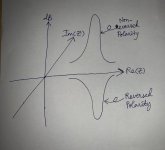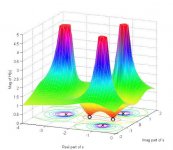Has anyone ever heard about 'two-sided pole/zeros' in loudspeaker design? I know there's pole and zero in control theory involving in crossover design. An audio engineer told me it's a name of design which has poles (or zeros) in the opposite direction on s-plane. Is it true?
Looks like there's some confusion here. If the s-plane is a plane, any poles or zeroes need to be on the s-plane isn't it? How could they possibly be in the "opposite direction of s-plane"? Not sure if the wording succeeds in conveying what it's supposed to convey.
Dear OP, it appears to me that someone has attempted to get (and possibly also make a mess) inside your head.
There are some filters like the inverse Chebyshev that have zeroes as well as poles, even for a lowpass type. The advantage is a faster rolloff compared to the regular Butterworth types.
Dear OP, it appears to me that someone has attempted to get (and possibly also make a mess) inside your head.
There are some filters like the inverse Chebyshev that have zeroes as well as poles, even for a lowpass type. The advantage is a faster rolloff compared to the regular Butterworth types.
Last edited:
Here's a few pictures. Sorry it's quite advanced maths.
Ages since I have done this, but when a filter is pole-zero asymettric left to right, as just mentioned, it means it has group delay or phase change. Poles of the transfer function, the denomnator, are always on the left plane in the usual world. Zeroes of the numerator can be anywhere. This is fourier transform or function of a complex variable.
So although the frequency response is flat, there lurks group delay or phase change overall.
2nd and 4th order filters:
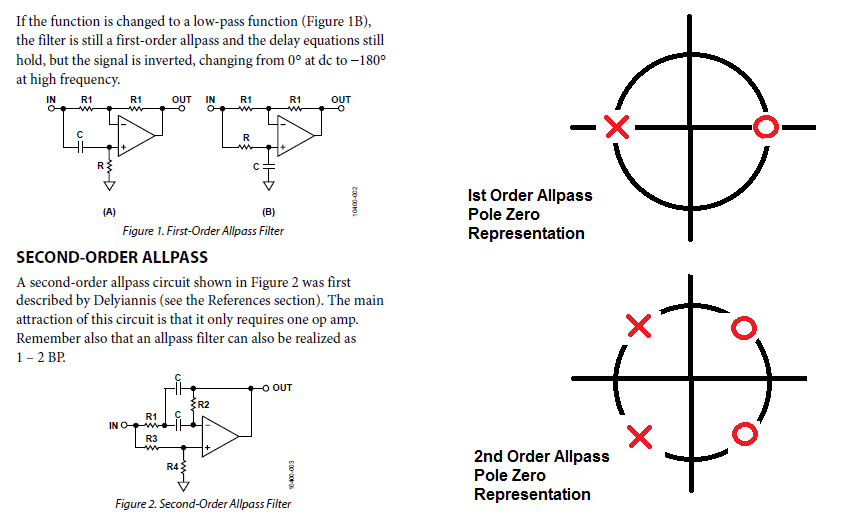
Sixth order filter:
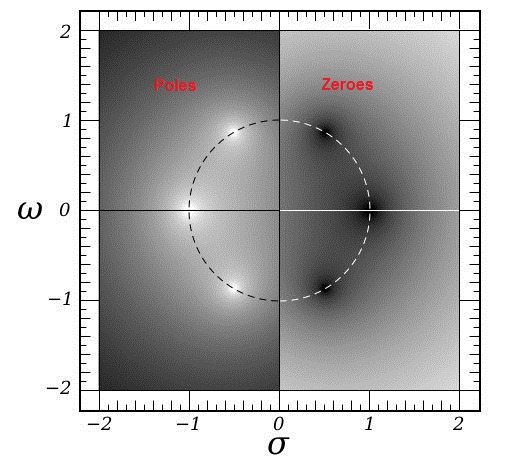
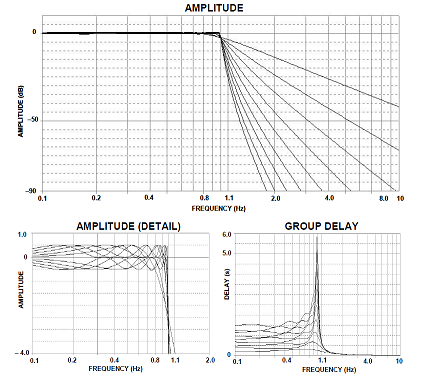
Modern digital filters can correct the time-delay problem.
Ages since I have done this, but when a filter is pole-zero asymettric left to right, as just mentioned, it means it has group delay or phase change. Poles of the transfer function, the denomnator, are always on the left plane in the usual world. Zeroes of the numerator can be anywhere. This is fourier transform or function of a complex variable.
So although the frequency response is flat, there lurks group delay or phase change overall.
2nd and 4th order filters:
Sixth order filter:
Modern digital filters can correct the time-delay problem.
To my understanding, he may mean that if the tweeter is wired non-reversed polarity, the pole is aligned in the positive z-axis direction and when tweeter is wired reversed polarity, the pole is aligned in the negative z-axis direction at the same x, y coordinates (sigma, j-omega) on the s-plane instead. Is my understanding correct?
Last edited:
Goodness knows what he meant, presscot... 
Pole-Zero is a way of describing quite ordinary filters at a higher level. It's good stuff, but you need to know complex number theory.
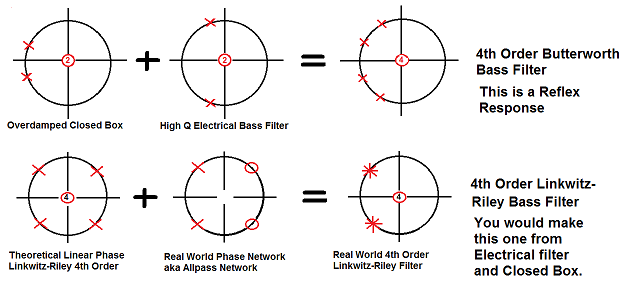
It's very abstract really, but convenient sometimes. If you have phase-aligned filters like Linkwitz-Riley, flipping the tweeter polarity will make a big hole at crossover. Designers actually use this as a test for phase-alignment. LR2 (12db per octave) is a negative polarity solution when time-aligned. LR4 (24dB per octave) is positive polarity.
This is to get the drivers in phase. Out of phase sounds hollow and the imaging goes wrong.
Pole-Zero is a way of describing quite ordinary filters at a higher level. It's good stuff, but you need to know complex number theory.
It's very abstract really, but convenient sometimes. If you have phase-aligned filters like Linkwitz-Riley, flipping the tweeter polarity will make a big hole at crossover. Designers actually use this as a test for phase-alignment. LR2 (12db per octave) is a negative polarity solution when time-aligned. LR4 (24dB per octave) is positive polarity.
This is to get the drivers in phase. Out of phase sounds hollow and the imaging goes wrong.
Last edited:
I just thought about your question about flipping tweeter polarity in Linkwitz-Riley.
That would move the zeroes to the other side of the plane. Change of sign. The poles are unaffected.
When you add the bass response to the tweeter response, you'd end up with a huge hole at crossover but linear phase. All a bit weird. Nature never forgives you for splitting the signal two ways is how I look at it. It's always detectable.
That would move the zeroes to the other side of the plane. Change of sign. The poles are unaffected.
When you add the bass response to the tweeter response, you'd end up with a huge hole at crossover but linear phase. All a bit weird. Nature never forgives you for splitting the signal two ways is how I look at it. It's always detectable.
I guess he meant pole pairs that are placed symmetrically to either the real or the imaginary axis.
I think it's something else he meant when he said that, maybe some marketing / advertising terminology devised to sound novel, like "two-sided this" or "two-sided that" meant to suggest that their crossover has two-folds of something when compared to the others that are just one-sided.
Complex poles and zeroes that occur in pairs are placed on either sides of the real axis (top/bottom). However, that is very common to all kinds of (2+)th order filters including Butterworth. However, on opposite sides of the complex axis, only zeroes can be mirrored as poles on the right half plane would render the whole network unstable.
Changing polarity (x-1 or 180* phase shift) doesn't affect the location of poles or zeroes of a network either. Nevertheless, inversion (reciprocal) definitely exchanges the poles and zeroes, which also explains why an all-pass function is not invertible.
Last edited:
Maybe it was related to a first-order cross-over, there the response stays flat but it becomes an all-pass when you change the tweeter polarity:
1/(s tau + 1) + s tau/(s tau + 1) = 1
1/(s tau + 1) - s tau/(s tau + 1) = (1 - s tau)/(1 + s tau), which is a first-order all-pass
1/(s tau + 1) + s tau/(s tau + 1) = 1
1/(s tau + 1) - s tau/(s tau + 1) = (1 - s tau)/(1 + s tau), which is a first-order all-pass
Here is the picture to illustrate post #6, the 'two-sided pole' concept in my opinion. Does it exist? With my little knowledge in Maths, I've never seen an upside down pole case before. Has anybody ever seen it? Please help to educate me.
Attachments
A pole is a singularity where a filter transfer function becomes infinity. For example, take a first order RC lowpass transfer function 1/(1+sRC) for which s=-1/RC is a pole as this value makes the denominator vanish, sending the function to infinity. Since the pole is real in this case it lies on the real axis, as shown in its pole-zero diagram below (p=-1/RC)
All real networks have poles with negative real parts, just like the above example. Anything else is unstable. I don't know why you draw a curve to indicate a pole. Also, your poles are on the right half plane, which is not very becoming of a stable filter network.
An externally hosted image should be here but it was not working when we last tested it.
All real networks have poles with negative real parts, just like the above example. Anything else is unstable. I don't know why you draw a curve to indicate a pole. Also, your poles are on the right half plane, which is not very becoming of a stable filter network.
Last edited:
I don't know why you draw a curve to indicate a pole.
Sorry, I was trying to draw the s-plane in 3D view. Something like this.
Attachments
Well, in that picture, the Mag(H(s)) is defined as positive (for any complex no.), so there's no pole that makes the function infinitely negative. With a phase inversion, only the phase plot would change by 180*, showing which would need another axis, i.e. a 4D vector space. The "towers" however, would keep going in the same direction as they're, i.e. along positive mag axis. Hope this clears things.
Now come back to reality to see how the mag values around the poles (singularities) shoot towards infinity and how the real parts for all the poles are negative. Also, since the magnitude around the pole locations is already known to be infinity, showing the s-plane alone (the one with circles) is commonplace and considered sufficient for all practical purposes.
Now, as to what that fellow possibly meant by the term "two-sided", just look at how the complex conjugate poles at (-1 +/- i) are symmetrically mirrored by the imaginary axis. Once again, as I already mentioned earlier, this mirror could not have been along the real axis, for stability related reasons.
I am not at all surprised that you didn't come asking about "inverted zeroes" of the system in the same way. Plus or minus, zero is just zero isn't it?
Now come back to reality to see how the mag values around the poles (singularities) shoot towards infinity and how the real parts for all the poles are negative. Also, since the magnitude around the pole locations is already known to be infinity, showing the s-plane alone (the one with circles) is commonplace and considered sufficient for all practical purposes.
Now, as to what that fellow possibly meant by the term "two-sided", just look at how the complex conjugate poles at (-1 +/- i) are symmetrically mirrored by the imaginary axis. Once again, as I already mentioned earlier, this mirror could not have been along the real axis, for stability related reasons.
I am not at all surprised that you didn't come asking about "inverted zeroes" of the system in the same way. Plus or minus, zero is just zero isn't it?
...just look at how the complex conjugate poles at (-1 +/- i) are symmetrically mirrored by theimaginaryreal axis.
...this mirror could not have been along therealimaginary axis (for poles), for stability related reasons.
Just a small correction in there. Hope that settles things.
Having slept on it, I start to remember this stuff... 
What you are trying to do with a crossover is get the woofer and tweeter to add up to a flat frequency response:
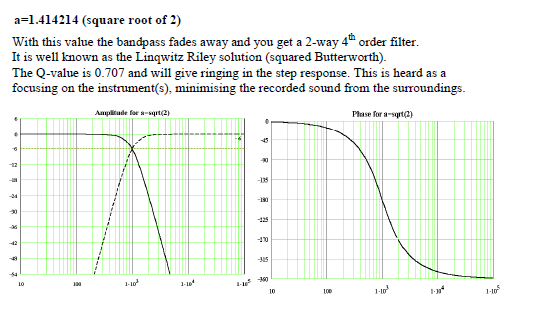
We often use a normalised frequency of 1kHz to see what is going on. Gets rid of the constant with s.

Circuit A is a 6dB high pass. Just like a single capacitor filter to a tweeter in an ideal world.
s / (1+s) which has a zero at the origin and a pole at -1.
Circuit B is a 6db low pass. Just like a bass coil on the woofer in an ideal world.
1 / (1+s) which has a pole at -1.
Add them together and you can get (1 + s) / (1+s) = 1
Or (1 - s) / (1 + s) which is all pass.
Second order filters usually place the poles on the unit circle. Zeroes are either at the origin or (theoretically) infinity on the imaginary axis.
A second order butterworth high pass looks like this:
ss / (ss + SQRT2 x s + 1) with poles at 45 degrees and a double zero at the origin.
1 / (ss + SQRT2 x s + 1) for low pass.
I can't remember the plus and minus signs, it's been so long...
What you are trying to do with a crossover is get the woofer and tweeter to add up to a flat frequency response:
We often use a normalised frequency of 1kHz to see what is going on. Gets rid of the constant with s.
Circuit A is a 6dB high pass. Just like a single capacitor filter to a tweeter in an ideal world.
s / (1+s) which has a zero at the origin and a pole at -1.
Circuit B is a 6db low pass. Just like a bass coil on the woofer in an ideal world.
1 / (1+s) which has a pole at -1.
Add them together and you can get (1 + s) / (1+s) = 1
Or (1 - s) / (1 + s) which is all pass.
Second order filters usually place the poles on the unit circle. Zeroes are either at the origin or (theoretically) infinity on the imaginary axis.
A second order butterworth high pass looks like this:
ss / (ss + SQRT2 x s + 1) with poles at 45 degrees and a double zero at the origin.
1 / (ss + SQRT2 x s + 1) for low pass.
I can't remember the plus and minus signs, it's been so long...
System7, here's an easy way to remember how the poles and zeroes of different second order filters play out.
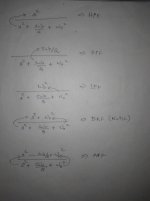
Yes, it is most likely that the combined all-pass nature of the system was what was originally intended, as the zeroes mirror the poles right across the imaginary axis.
But presscot seemed to think that poles were the "stalagmites" in the picture (post #14) and wanted to know if they could be sent downward by way of a wire reversal which, clearly, is not how things work.

Yes, it is most likely that the combined all-pass nature of the system was what was originally intended, as the zeroes mirror the poles right across the imaginary axis.
But presscot seemed to think that poles were the "stalagmites" in the picture (post #14) and wanted to know if they could be sent downward by way of a wire reversal which, clearly, is not how things work.
- Status
- This old topic is closed. If you want to reopen this topic, contact a moderator using the "Report Post" button.
- Home
- Loudspeakers
- Multi-Way
- Two-sided pole/zeros
